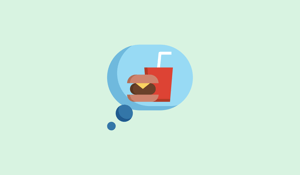Developing a healthy eating habit requires eating according to your plan, avoiding impulse eating, changing to healthy snacking, and managing your hunger. However, it’s not always easy to identify the difference between hunger, desire and cravings. As humans, we tend to mistake craving for hunger. We might have difficulty distinguishing the two because our moods and emotions sometimes cloud our rational thinking. It is important for us to learn the differences between them to prevent eating excess foods and sabotaging our health.
What is hunger?
Hunger is your body’s signal that it needs fuel (food = energy). Hunger is a basic survival instinct, and eating any healthy snack or meal can satisfy your hunger. While we must address our body’s signals, normal hunger is not an emergency. Habits like skipping meals usually tend to trigger people to overeat. Therefore, try eating smaller and more frequent healthy meals to avoid feeling too hungry for too long. To handle hunger, it is important to examine and understand what feelings arise when you feel hungry.
It is hunger if you are experiencing stomach growling, headaches, difficulty concentrating, or dizziness that intensifies over time and will only go away when you eat food. You can also try drinking water and see if you’re still hungry in 10 minutes. It is a craving if your body signals you to eat something but not any particular type of food.
What about cravings?
Cravings are caused by either psychological or physical needs, whereas hunger is a biological response to your body’s need for food. Cravings are more of an emotional trigger. Most of the time, it results from junk food addiction or an unhealthy diet. Cravings are often due to the person seeking comfort from certain types of food, such as sweet, salty or crunchy foods, due to loneliness, boredom or stress. You will feel like indulging in your guilty pleasures like fast food, desserts and chocolate. Food industries thrive on producing human dependency by manufacturing addictive foods we crave. This is why we rarely crave foods like fruits, vegetables or nuts.
You can recognise a craving when you are not physically hungry, and the feeling of hunger doesn’t intensify as time passes. You will also have a powerful emotional desire for a specific type of food, typically due to emotions or hormones. Cravings are not the same as hunger, as they do not indicate your body’s energy needs.
And desire?
Desire, on the other hand, is usually caused by habits. It is the urge to want still to eat more even after a big meal and when you know your stomach is full. Common excuses for desire are holidays, seeing an appealing food advertisement, or using food as a reward for accomplishing something. It is vital to understand what lies behind your desire to eat so that you can work on addressing the root of the cause.
Luckily, over time, you can restructure your lifestyle and take control of your cravings and desires.
This article is brought to you by Naluri. Naluri empowers you to develop healthy lifestyle habits, achieve meaningful health outcomes, and be healthier and happier through personalised coaching, structured programmes, self-guided lessons, and health tools and devices. Download the Naluri App today or contact hello@naluri.life for more information on utilising digital health coaching and therapy to become a happier, healthier you.
